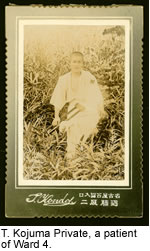American Angels of Mercy: Dr. Anita Newcomb McGee's Pictorial Record of the Russo-Japanese War, 1904
Medicine in the War
With the ascension of the Emperor Meiji in 1868, Japan began to rapidly assimilate western ideas and technology, including medicine. The Japanese army developed a medical department indirectly modeled on the Letterman Plan of the American Civil War, creating a system for removing patients from the battlefield to hospitals in the rear to receive surgical treatment. Reflecting recent medical discoveries, field hospitals included laboratories to aid in the diagnosis of diseases caused by bacteria. Surgical wards were stocked with aseptic steel surgical instruments and supplies.
Applying germ theory to prevent disease, the Japanese emphasized sanitation, which was consistent with the traditional stress on cleanliness. Water was boiled before being poured into canteens, and soldiers who emptied them went thirsty until more sterilized water was provided. Troops were required to bathe before an assault and sailors donned sterile cotton outfits prior to battle to ensure that they were as clean as possible in the event they were wounded. As a result of these and other precautions, the infection rate among Japanese troops was considerably less than in other wars of the era. "The great disease-enemy" in McGee's phrase, of Japan, however, was beri-beri -- a disorder identified later in the century as a vitamin deficiency. Due to the absence of vitamin B1 (thiamin) in rice, the army's main food, many troops suffered from acute paralysis as well as crippling circulatory and neurological ailments
The poorly organized Russian Army was unprepared for a war a continent away. Medical support for the army was inconsistent. Hospitals and aid stations were frequently understaffed. Discipline was lax at the aid stations where wounds were rarely washed or disinfected before the wounded soldier was evacuated from the battlefield. Since ambulances and litter bearers to send patients to field hospitals were rare, the wounded accumulated at aid stations. Hospital trains, some outfitted by the aristocracy, efficiently evacuated the wounded away from the front. Russians generally were able to get wounded off the battlefield even during a hasty retreat. Field hospitals were well equipped with aseptic instruments, although some older wooden-handled instruments were still in use. Russian bacteriological laboratories were deployed far behind the front lines and were underutilized.
Although the Japanese had more wounded soldiers, they treated them more successfully and suffered fewer deaths than the Russians. Ironically despite apparently stronger Japanese sanitation measures, very few Russian soldiers succumbed to infectious diseases. Dr. McGee and Major Louis Seaman, an American military attaché to Japan, promoted the Japanese example as a model for the U.S. Army, but postwar analysis found little difference in the success of disease prevention in either army.




